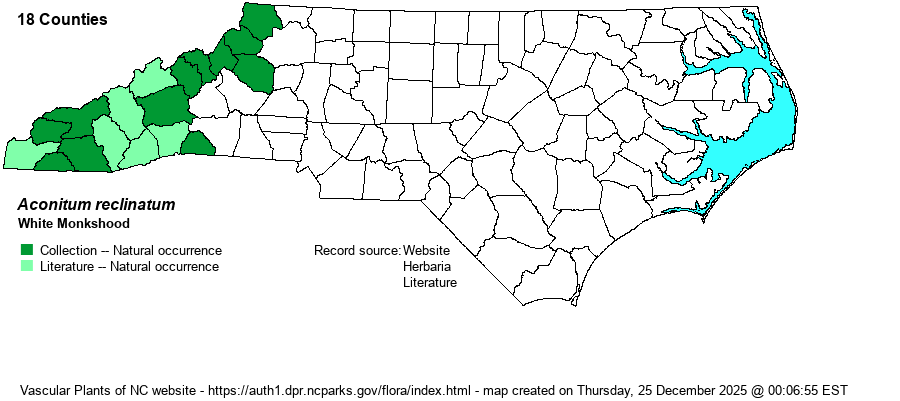| Author | A. Gray | |
| Distribution | Throughout the Mountains, mainly in the middle and higher elevations; records for all but one county (Alleghany). Does not occur in Piedmont foothills.
This is a narrow central and southern Appalachian endemic -- ranging from southwestern PA south to the far southwestern tip of NC, not ranging to GA and barely even occurring in neighboring eastern TN (just a single county). | |
| Abundance | Uncommon in the northern Mountains, south to northeastern Buncombe County. Rare to locally uncommon in the southern half of the Mountains. Can be locally quite numerous on a few mountains in the northern part of the state, such as on the Amphibolite Mountains in Ashe and Watauga counties and at Grandfather Mountain (Avery, Watauga, and Caldwell counties). Even so, with close to 70 records, the NCNHP lists this as a Significantly Rare species, though it does have the State Rank seemingly appropriate at S3. | |
| Habitat | This is a species of quite rich and moist hardwood slopes, preferably on high pH soils over amphibolite rock. It is most often found along or close to forested seepages, in cool and shaded microclimates. Thus, it is found in Rich Cove Forests, Boulderfield Forests, High Elevation Seep forests, and Northern Hardwood Forests -- mostly over 3,500 feet in elevation. |
| Phenology | Blooms from June to September, and fruits shortly after flowering. | |
| Identification | Both of the state's Aconitum species are similar in growth form. Each is a fairly long, leaning or strongly drooping, herbaceous plant, reaching about 6 feet long, normally drooping onto other vegetation. It has scattered alternate leaves, each roughly cleft into three lobes, or weakly five lobes, strongly serrated on the margins; they grow to about 5 inches wide and nearly as long. From the end of the stem, or from a few upper leaf axils, grows the long and striking inflorescence, a raceme or slender panicle, of 10 or more flowers. Each flower is creamy white or pale yellowish-white, about 1 inch long, with a narrow helmet or spur shape, with the spur extending out the back. The flower is primarily composed of the 5 large, colored sepals into a hood shape, with the 2 petals being quite small and concealed under the helmet. (Most observers would assume the colored portions of the flowers are the petals.) Its "cousin", A. uncinatum, averages slightly smaller in overall size, and its leaves tend to be divided into more slender lobes, normally identifiable by experienced biologists by leaf shape; and it has blue to lavender-blue flowers that have a quite inflated hood. A few other species in this large family can have somewhat similar "maple-like" leaves, though the flowers are unmistakable. This fairly robust and striking species, even though its flowers are an off-white, can be seen at a number of natural areas in the mountains, including a few places along/from the Blue Ridge Parkway. | |
| Taxonomic Comments | None
| |
| Other Common Name(s) | Trailing Wolfsbane, Trailing White Monkshood, White Aconite | |
| State Rank | S3 | |
| Global Rank | G3G4 | |
| State Status | SR-T | |
| US Status | | |
| USACE-agcp | | |
| USACE-emp | FAC link |

